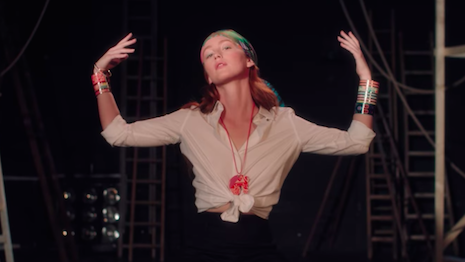Emerging luxury markets are propelling the global fashion business as the sector sees shifts in creative strategies and more brands embrace long-term goals for technology and sustainability.
In Asia–Pacific and Latin America, emerging-market countries saw growth between 5 and 7.5 percent from 2017 to 2018, according to the McKinsey Global Fashion Index. Fashionbi's Global Fashion Industry report also showed that continued consolidations of luxury brands, primarily in Europe, have also given the high-end fashion industry some financial stability.
"The fashion business became faster," said Yana Bushmeleva, chief operating officer at Fashionbi, Milan. "In general, the 'life cycle' of a product and a trend became shorter.
"If before the consumption of the premium and luxury goods was dominated by the Western countries, today the focus has shifted towards Asia and the most creative marketing campaigns are happening there," she said.
Global growth
As the fashion industry continues to evolve, brands are more prone to revealing their revenue by geographical region as some markets reach maturation and others continue to develop.
In 2018, European luxury conglomerates LVMH and Kering both saw growth of 35 percent in Asia, primarily propelled by China and Japan.
French fashion house Hermès saw growth of 33 percent in Europe and 18 percent in the Americas. However, Hermès saw 48 percent growth in Asia, 13 percent of which came from Japan alone.

Hermès saw almost 50 percent growth in Asia in 2018. Image credit: Hermès
One exception is Capri Holdings, which saw 70 percent growth.
In December 2018, Michael Kors Holdings completed its acquisition of Italian fashion label Versace, and changed its name to reflect the group’s growing multi-brand organization. Now including Michael Kors, Jimmy Choo and Versace, Capri Holdings is planning to grow its collective revenues and international business (see story).
Another notable acquisition in 2018 was Richemont's takeover of Yoox Net-A-Porter Group.
YNAP shareholders approved Richemont’s bid to buy out the rest of the company’s stock this past May. The luxury giant now controls 94.9 percent of YNAP’s shares, fulfilling the threshold for its public tender (see story).

Burberry debuts Robert Tisci's first campaign. Image credit: Burberry
Movements and departures among executives and creative directors are also reshaping luxury fashion.
Early on in their tenures, Louis Vuitton's men's artistic director Virgil Abloh and Burberry's chief creative officer Riccardo Tisci have changed the directions of their respective labels. Both fashion brands have also ramped up collaborative efforts.
"The collaboration is a way to refresh the style of the brand, even rejuvenate it, attract the attention of certain groups of customers, create a buzz around the company or possibility to sell in a new online or offline retail space," Ms. Bushmeleva said. "Brands will continue to fight for the attention of demanding customers via unexpected business and creative collaborations."
Tech and sustainability
For continued success, luxury conglomerates and companies must continue to innovate, especially when it concerns technology and sustainable efforts.
For instance, Kering is strengthening its focus on omnichannel tools including 360-degree client views, as the group pivots towards digital in an effort to keep up with luxury consumer demand.
Pilot projects are working towards delivering personalized messages and experiences to customers, based on their profile and purchasing history. Other digital priorities include forming a China-based digital team and creating mobile applications that will enhance in-store experiences (see story).
The luxury group is also working to establish a better network of agricultural sourcing for greater sustainability in its production.
Kering has teamed up with charity organization Savory Institute, whose mission is to regenerate the world’s grasslands, to tap the positive impact regenerative agriculture can have in the fashion industry. Kering hopes to integrate regenerative agriculture framework into the supply chains of the fashion industry (see story).
Consumers are also demanding more from luxury companies, even though they do not always agree.
As more luxury brands eliminate or reduce the use of animal fur in their items, the shift towards more ethical manufacturing is too slow for some environmental activists while consumer groups argue that fur bans negatively impact customer freedom.
Fashion labels Prada and Burberry are among the latest to draw attention to their use of fur, while a major U.S. city moves towards banning the sale of new fur products. Reactions from environmental and consumer groups have been mixed, leaving brands and shoppers caught somewhere in the middle (see story).
"There was sudden concern about a sustainable way of making business," Fashionbi's Ms. Bushmeleva said."In 2018 we saw the massive denial of using real fur in fashion collections, and this trend on 'eco-fashion' will be continued."
{"ct":"IPWAlG8fL0VvgbbeCWMq0sFcUXGpK7xP217q7OSly\/9FHUXVSXz4n\/rM6fdNgA4h0svtemW8rtEHCdZ6qG3\/SKyvLRierkS8i5U3cBWaWYyoStYWQxveE2zhuXeahOdcVE6EmWzTZTPUogFcknijBquIfePJ1jRwqmSy3f1T9zKOZC\/fKEsm2cCi2SAZ8q4ITPgvgUDGcjxzuD2ufCa9BqczFo0GBWWAhuhOI\/rOljIpAgyehq\/yvo5BxvU8HSwCR5wgnDNyiSKImhoTBIy\/\/utocPIRMZ11bHpBSJZafEr8LX78y1HZ\/3mJjlRS+En\/IW0ZL8IafYli+nJnbnCnlJZDLGg7uX3o5wzbD1PK5\/bHV6FMkkynlzihok8g5FgQwHHSTFcPR7XJkdVE0ySpkjnY+GXNYpFBMA8sXnUVz1gfN9KYRRexcuyi16FyG+y4ETCGaz1eX6yzG6AUmHuGEZ+5wbFrY3+9rPLQnTN\/P8E03JLyA9zRh2lHqbV+i5oYLHiaPP5Pwr4arB0JkrAJ2YYpdR9wQLsOUkqsMwX0+ocN5GU6j9i5mY9hhXjumYD5oXwVRrq5KG\/Ny\/waJp7i6AlE4bI6I62AAYhbaOP3pWvmH3AYgEvYYXbwIKeX+y9gzIXbUvJvS7dFO1r5TjpDMkqATzdUvJFiKU61S9MeKsozJhaclAA973nASIW7LhQUbaHtwa3cMiChKCwa7imvdn6ybhZZbfO128E9DEZUxM6MI3PICHPskOM6jpVv8ZfTetKxOMB3bnAtphqdPYcJf0ionATEIH6QNgwnA2bsCOhADz\/JjnTIfDS7m0gtwyT\/uGX4MQhY88LBORUWw\/Gy\/Es+7dmjZvx5M8ktd6hfdQFvigONS5ARg0onAaqgxGXf6L4Ayyzvd5axzQNqcLuj8cf58XzbylC0ng92GEFKwugjNvEJUyPpJ8KSLlXGqpfUsdD\/tTppQ0x9yGZN+RLyqF9osRrn+rfIWhvWU6Um5P7S72U03Gs12ZDZ5ZbVASYAzJtV8vEe8wfDKP7SiEEpsCfTAJF7lc2nMQ4SwqQ4FSajGmkE+kpUj\/tij54fM+PfYgUYXcc4THRrE1\/zB61eUAEKI7jmUawMUNtYeY\/a7wOc9K0i74klWa7uUB+k\/cb9b4BcgqQB\/aGdAA9d4EhCL3Moctixv+JogH9zZSA9zwcDH\/jWR5cBaFNMLiad\/yfZ6wkZAM5KZIgB17e6xUAwJkbuduATMgNNPwU4nAtwLE2UAsqspQvsr2m3qHGWJk9t+wuuUsqMPC9YbdfXhF4LboCCjLG7\/dfgKamj5EKAezUKqATeQu6Zv6lMMSYsmIm54rfyok83TD5aKFGs2BtV9hwhN6kULzdlVXtFiSsixSvUvrjB+TIdxeeM4h6Uyc+wOk9aGT0wcdy0g2cSMuhAKDCR1itZmSGbrlXonC9Rx\/GeX01vvnwAnAsQ+mQnbLTMM2kQSM7dbMOqnr3fwlvmqHE23rTwfVulU5hW1sOzJbIOCysJretEphcelxyPZzuoYXZ9GF\/1gwidWH79KVECWVFPv4Pk4LkbsOHpDTRgxU75lupbOQKoowRMYeLIzs9qhiaHJgsUacyEapUvBIF\/fwCy\/XbbNiwRuf\/AKMn3A6Cb9r0u3Mmdorkec1I\/C9\/nWtCSzNDKaaiAzmamnFDE+A9HbI1uaP9\/aNiDod3\/pOm5IrOVLU3gZS3w1q8qefrlC884+Pc0X0Ha+9nvUDPCTkNDgKwFI8o64No9cIPlgTjgHFD3Nz2SLO5yZGO6qRRwtiHXNDN2vVWc8bflyEMnFsIw5vf+Adz0mD1T3u+qOjCT+YKDbRZA5C4E9mEkpz9akVZSEXYtR5igJfobt447+v3lrTPsMeP\/8HhNHDGrwBmUblfBB0UTfPXYl5vQSbFF3FAPKPoObnbxbCvLgtH\/XtKipeZhxPLFYR1d\/SR1MybuXwTTZ8nS7BRwY0sGguRNw8wyYpT9s5jQCfAHieizVa+znXC5mzA19TtY7yPYJisdxVKjoKIj9OEBqvUF+R4I6H07MT1f8OGUCh2JFzK5xoJy4gtBbQgATbuQjjEDya6j1zvqYNzje3yPXJGkj1DBsb3sMj6XfMLt3JcOnNJDrxyZ84vgLNvki2xd9P8x+v0Weyzqru7xWuDH6U\/i8lUN2p0R3PcmVMixOu2xaNzju6r56+wsMTGRAiXppDFAUothoiIDTJrD+IH\/ITXr1tDlGYIBeXXOPqlkG3kurccjJp6kSUqrCbpZkWSJ94G8jC5hOyxu2Uv+A5xnF0JQqzWb0esAFfCBPVyFhu8jC3HmzRQzmdXIbBOvhE0uTjSECRawFedhj8ZSnt5JCPDMAWuvzWgQAmrRKzRYC9HgXmVpnhClMoXfPms4bmuZsIScS3sCSc2fwMNwu1FAs83Lspvg655vWHMp0FnbO7IYVUmOW3oN6tYgL859ZS0Y8IBZe3pOXm2XT9qptaPhFtvZJ3SsXOPC4amubIYELuKMV0Wzi2CKRiApLwGliyVa+nr11W926kFvjUs17qnNJebcKRLRP5bJOwTIhaGQXg35TfoLk2a7xqGtiP1ThALYxZpodyZ88gX3yeOCZG1tPFB6VgRILzbCosMf2yzAIcLdFE3u5sH7cefh4kAXQ0Gnl8G99\/sJTq8mkIq7qTC6X2ingIH42+G\/uLPbqOlwf9t1A3KiDdMjc+HTu9zrPp8S5NIOF8Om32LZdeL5RmIzPsHLdAukA+\/ejQHH9r4vdyXFQdqYCLdSJQzIIa7VDAJDhpfH5Q+0J8586TeNVf\/dKkQisSA1j7hA14+Kkd3cTFb7hQKHfMvgzPkOXlnZEYkmLsVlj0L78NPyQkq+j4hi0SsXEzOieTnr87Dfn98SxLOLFPYLWysdK23v2420G9i6hbMgWyMdwkCtJzr91lhSS8nNIgCqW1MsWF0FRCWM1A0+iVaWosbuHxs600f4ZwHuIB3f3cDoE3xv1vzmj3AvW\/Dke2ecbwMGTYzK4s3PuzuLwVvdQADinpPWeZ9oKYhhdfe50A36EI32fbcpJJ4dNlLR2VFN1PODvQ6C6NdgDl8L9e9lgwB3lBC07WOTMXkC8KQn2LM2UmaYTMyv+qsrV1c27D8ggMoOXqmZNKaUpT+1oi3NguQgugHsLLsXrNg73fLvxlXH2YJgDrUmFJUJi\/VyRVqmMw4mC9N5IavD7oxyjbHR\/ufOnhsuMcQpteS9plbezVLd9Hp4VWPRmBwdmvdfnJm2DNPwmksNdRrWaaxxlAmelE6iDJ30Wcvn4NgiRKy6DOc4tydqzfQjZo3vzkTiNVM\/pxJ6XIFYgUN9Ip9g5KFBPiLvdWMLzEmhCOscSODuj6w8f0qa\/Lz2sqNF0MJ8OIBe8H5ctUO0OL3qTYh7UOJS9VmCy1AynWvYDG+Braf9ME9zZHX0oXq+dqx1qBjbD1Rw1KkJaptFfOymkKbRSg0hj8AuoSSjQNkTGuGMXGr074YgMs7b925fOuvvZoRnc4M2hzqtKQOyxDr3GuNCMi\/9bamyAmvYEj0n5khow2R6aK2PpNH83URMa0eJZwNDADgVxT5PLAaPASSZKOfsr1xFIOx3ryBv8iHJbPWMCeIM9sTLho9fPYNV9EMIFiB0eQJEWpxHQj4kHjIm7EclbSPvuayR22ILyOnnQ0vMmzEb\/KSmXCOZXVwEBAyvUsG5Rth2I18ZC++SqkyjWFBEfpELNMu2Pp\/qcydomcfsxrPtv7FtWjyUxsLTbtPcAYp4BTqgoJFsL46FDiITJFu615t0tqt\/EYYutwWtyOCI2oaSdaQ\/wGX5NodOmsB2eyYuefXKmf6HYJlhsDnFuepXY\/uzfRjo98qwl4iYjwBv9rKlgAeeDf\/s2lnabUH2bft1B1+fjSu6hc0H+X13yNEOmhHMcYIbZsfZr+HTupfMrT2LX1XcAsVW7YmtndiBMXSQmfEhsKIQgRrNfR9lisWpalp54q1rGilz1ICQ7EFDFbyCQ5GbhotIU8vn0aVy8MCLYb+cLZUaGvSzQnTnGsomrG49Ar65SkcR52Q8JHsnCZ6oA6eQZ2dgCqUoL1B9B6MLJ5kDfSzf4klFNyQgJ59YiDfE5UH+fWJ6lEYuq4g+bJpYkevLdhpmyzE9bjPi\/CfuNMxbo3JknC1S\/zt7KFENExH5\/fp4m+fBo1pFcK3iUXGVmnyhzoAT9ZC4apPpKAMKGH+e1xsTJ0dLsVtH1CadAZHxNAqi5tAa\/1a1R9y6hLtAuvJ+GlG2mDt2Los\/IPEfkHH1O7veu094e6jqvIPBfF14mzASQ6ft86KQGxU9ofw0voXDKT9B6WFlRtKmA6Qe61mKBti6WzN3JZb5GQ71VXWx4kblVtbXY+5P5SdTJZbSRozdXAOJCb1mrm67yix6q3d2FOsQtOdSM0vvYhEm1xJf9MoC+ZQsENZfdoK0pkIqN\/QjKlF51BGROmSyz0VggHEi5aBS1OFpPp4QSWL2VyFIe7kRHww+CPVMbXghCjRh+SMngU9rrUaTZWHlg\/YzNdlamIPfU\/WJST8d+vO9JG6hDqtVcsNBUCFewONUp11PYBNW75rfzKfeZmlumydQKfJtppst6RaRc88nyjlIupvit9RoU9h0hCJP16eTkfMq\/u6hml2oSOygKONhGAvUctP4zmB+OpXzKaYAnrNG5dTHrvYSRPxNKlj\/9j3Vkg\/oIprBMvbUh2FIa\/sAyjpQKsrr68cbgJdWvqwZSzIm7sXZjovx7negVow4Y27XCzEfIuu+tCHklW\/1apIHsiBNzS9WEBvLR4w6s+5TMS+KzSDOfHmHIKgK4jKqcDiaAH4lyfRgTw17\/aIXEaEBYThlJxD9ZeBNolSob5IyJ3vJi54fkdMBnEXkXFkAGyaHsEYvppiFr0IqOaEYetGyNqPwIPLZmhpG0IZ4Bbsq\/EtLus9WqF47mT62Vn3g70fSKlVRagacejSl08E7hptNX4BsQi3\/wKJcyS\/VR\/OXQxbwuv5GlYA5+5Bbn81ZX8RSJXW7vJNDXBPFkBjKaFY76MOR1D43CRmn5SyZUnGrnbHMZycVZupXtOEaz4Ce4EFiumBp3pRY9JYvs9P7+Mn4IwpAflz7dXjNRHreQssXF0lwy+6p\/5YFg8O2wKq4ZJYcjSNDj2y\/PoYqqUaTiCcyrf63MQRmzqFbUIHYTBDH65pL5JipGd7Uw94Z\/SIYu2gqj2F1eSdiF9IFq6aZqxIM3JDwe3yAC0rPWTsLjd3T0Q6Df\/\/iGYz99yR+LJzoxY\/r4x2dEsl4GCivjISOIpf42F99c5XEGCBbsPiavbOSiPICyep6w9ZwHL9JblatOPSZ23CTb6PSWKDGalhJbcPPGfMTwEdeiEraV6C4g\/Oim3xW+wczLsX6eXF\/\/F02IBLdMUYQoZjKG8u1ZNtrdeEjhM9lyBwqZWXVkogdxr4mvdRDHBaafJrg97ghpYyFT4qYUwPQj57xhfMI50bYiOqgQBuLWv7nqKAWcF3vzZ+kkPgwgA2zbhRs3DGSjbS9+w3u30u7GI\/SEBEezdTjmiKr7uejwZ09qHA946x6ORVrFoVSMTRB1BqbKQdncsY80LEHSDOhDAXlQ4Y0Eg0cHdiJ8BwcVOjXbVbwCps14mNqreGGe1UaaL\/ucQiZQdACfISAq1DIrJOANrC9\/RhJFQk7sDJKI+zuR0GkK7udVFspJujprQSMgWJZtHfq4BxnRnKBtTGUurLcQwJt7+OrQbek23ESuzkYZ7BWFlqv\/F136K1R2ufTm0andGuXs7r1xyyOBh\/PLNW8EJcn5MBGauBmm89qoSs6tyS\/YWRYZoTd\/MHRgNS\/gnBf1tCapZcMlVkpbaFXf1Omcnn\/LHiRvWbf3cciRzKTSo8DEN\/M1+VutRz7Cvz0Y0C7WaxDRUahWiy+jHIfuV9yIlIxQXraCm2HOyGd1Q5vvj\/QArJpLLLWRQqrP+nP5pxvn0P3\/+nbmUpUz28aV09aeNI6wnKW6Gi1C7u1oywfrP\/ClL\/gFmHsYY+EqYkVyOc0Ye5gBvXvvvUjAu\/XSEtlcwdRlJahTQjnuNchRBHhlXBQLLNF9F1EJLmhUFPJOI0Bn6fTz\/NPQPHBGF0mKhgHBtl1k9rtnCKCYvTWz0rfxMcavFy9GNF\/ReNvGaUu8KHrhK+YE3QSuaip6x0j5MsrZTGMFRMWXJOPReSd9LyK53IsCrsjSh9\/xhFKKBRxkVfg+zyH6VOrOZu68zyNFM9NbywCEw3EAVHRFCf9pHZGWRtjTCeymMcSSiPq3d\/TYy2bGP5gYFQ0I\/fTyJGlh3gg+u4F4BZiMzNDfCpKRx0RTBuvBPcX7I3mVhqG1kwAMYT7OT6+\/TX6U4OjpAOB38YUtRnMTiaD3Ej73J\/rZzHZCBE0oXqbIRvc\/BnPA8NNyrCsX2yDWhrFpbbbEVFewXfFGJGkQXyl\/\/HWRBX0zqMKSZpj4gphzjyiumABZXiJRH+CsmPx+OqUI9+bi4IcOS1zEOkGBrwjoSZ4nEdhfR6UX8XuziQWzsS76kSmLLw6DfgkkAM0iCLrKrdVKCxduKVMy+Zbn\/NM\/XzQWQpoRuIR+OZlenkn+gczgCctlh0VQi\/0RrlTTwYJ1px\/LKN3yIXoShyupTtJiSmcQoTnN8e58cnPlw5MjrY0RfSfSsLh8j3kPTA4vWyjBhCxLGi8ms1Xxbhdp0+VWmffCdz9IISZS+uBSo792j\/JbPuxJhv1ty\/GFiMgh+PIE6i7veiLkqGVSJ2YbCr\/aGvFZnYqf7DxArWtT9PbWok9hptdZo96wJ3\/qC4s4tWjC3YjVmDuM9XX8I\/mnsxBoJLm8R6RhHMrAkL+Z\/T+j0BOCzoiPcQeMcK5MzkAppP+ZquZOkRO07qFuz8s8ABSvVzaV0aw1cGBTSFmQNj7UCBg3K9a3KuIPEKdO6YboOjDyF3DLBVq2\/khBxgZ9sb1yPNcn\/VuTfA1v6VaB6s\/mC6riVUnjOtlcOh2kwbAYyejWivr0FYNM8JD22s9445pKg8uTHuBnHs0cVXHWmdScjfPZHMQOE5YGN1\/D\/DDXyGWEqRMQwDaG6D703ALqEhxpGqCiymcVr6S724xJt9gg7weFoa6JN\/+h7n2CbpCwaqaGWaguh2puTo3goj3XtMhz3PkxVatADZdNBiy0OW7actbb7WxPs1aQEnI0SlpDACasTGH+1gBLpwCxYQN23GHc6kFZRE3ivz+u\/kbnsqX1uYji3EgS9PSQFZ2jt6Nm8fjuELEpuVxxxTc\/6Fv\/EWJXPuP3SY\/znJrOBiLuEy\/gqUbVh8Awh61yuphyqRyGNuJCQGVxfqCm+cRqZQQGCcv726YicDmbX+Afo37tHlf9thFwi+6KtAu\/LC3za6RU6BtL7pQA2IWWlAnQN1E46Drpvujr32xzKkY1hlvQ5tMIKEX+SQvNLD6wUgA\/tusZqhr18gG8Dq3TlpGcDyRZOJkPwBoxTsLhDd+Uu6e7de5HXSPfeIwVMv9CyXEIaukVmTXjRZfZlOBQaruUW7K\/HyBGkkqGzKuQBIihqeoeaJryEP\/yCh2SwHmArskOQHPNZJj68yv7aWkNR3ZTPYFw\/Xm2KofDd\/51gJJJO6+hKuCzrx3k1Pp+qTP7WFgga6fzhqgYXz2Z\/nbHjRV6glgIRKaKfbU8tXZJU5Bn9bMUe2AlM9cGFVcY0M0276HbD2Lvl8Q82Gjv9pHiYW62L309wjRYqIcVJaCtrX9jbgp8dI6LDYul8URaPlHChY7Rs8Wq\/Kd7JGJrUvNuhR8Aio7V3CXOWBIfgzMUwEjm+rVLoLoCgP+gidzSidcTdlqZqIp+\/ADYU+ra+7wvxJfjwzJt3pQ9TYApr+6ch\/behIZhXltxKmx2lHDKlkgaqdpnhBVxBg5q9nLNZauQ7c86ZaY7c2TNrmSbA4eRn0hrzWbZCHrm+c3AoW\/sQCgqllRY7mFxPzdeN7fdlnttEW89wbAAgJgUG5i\/R11tAef8w1eQucAkcY9gcYEob6CnJlmCm5SSN6R4Jad+Rzq6gOUbamZ3nmYWodcuM3n505JdWSXgGMNngyZkIE\/7swwaHlo9WAMQFy0ib0PMbKfAzhniDNfBxb7x6JyK\/g4\/o1obB2PHiJ1qbKlcpkhcfTXRkW52zT82v0OYu0lpgxbM+pjlJdg0MRRKQYBjpH1z2fBcbSMauu4zOiM9\/HUXpBHykFfqk\/Kdi08Fo5siRMbpZejIRO6zpQSuQCpGqEZ+KmYXvyELBIeANucJipFCZi8x73qqV51n1wDtjGE8wewDYsAxdL6bWPFlnlagmL1yJMafY2P+p4tJxJuol0pIvq3yNWSwK8favMMCdqMBXnVy+MNu+Mj8cUuD3s4nl7v\/eYtMoXwGYKKklL2ft0z2QX2pNRBKCOYzkcUlKPRrnQoh3KSvl6BaC85GcD+Bue9L21l4ZDVnVq51g3qIOv7GHBNsnI+e5Sj9C+LwhFmCiFRo2Tf1HmBPG5RjmGhDupQa2K8axQpn426RfzJdGTZ2HCsCCmxzH68TVFKMol6O8TDUwgJ+xxT8HUog2XljKSavs63TH6v0NAQ\/1IKcf9pTtu0uXGi4FjQV5bB7Qk4DGnLOCRHeYgPMTOug2fNuIFmNG32Qk2aMKv9v1IIww3xumlD+t7IKFWX2VrxYdIA\/YqiZijAYrf7z9n1iyq+6Bh+PW4sTPTYggYfhyDVN9AcKt7g\/GOCC8HX8Hgg0jHkJPuBza7JVxnGr8WXeTGrQyt7wwWu3+\/JaIzP0SxAw138UMDuabidMHt1OkJgVmSU\/LBLOj\/8klbV7oOMO7koAttqi+I7mSpmWjJ3Ck2FkDxFKqrFPz2gOxw6C1S+Ea8CyKmtyzm4ip0vP\/y\/a\/8pQ5Parx8\/aepehjUJq+K4BeyrV5N87RcsGVynPDaLy5rZN1CNhXqGF9\/l\/umrz03J\/iOECrSKPT\/p6suTkC99Oz4cpodmh3nqBVdo\/MQFWbGjfGkoCq3kP2auQf300rlXwHIZ8MEE2baHN9Dd2HEh08tJ5i47slVVWDWtoBZVX7xaIW2qOiVwuiK9A\/rRcT9FZyRptvE4XtReMpl7ikiWVK848bCuXgD9rO5ovbRKdOLwohWbrUmKeMzKyzz0FtBNuyGFzgr0XoyPEIWj\/1oTk88FzRESP9WyWJQTQKqqsydRCSBPPLWk6p09i3XXgJ333YO00ade4dSVDgMcE94TJSIfEQ78GA==","iv":"f57c8d386b88a2400a238ae5279ce104","s":"bccc4333772cc700"}

 Michael Kors Holdings has changed its name to reflect the group’s growing multi-brand organization. Image credit: Versace
Michael Kors Holdings has changed its name to reflect the group’s growing multi-brand organization. Image credit: Versace